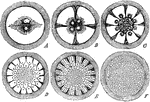Clipart tagged: ‘egg germination’

Egg Germination
"Further development of hen's egg; after Haeckel: A, the mulberry mass of cleavage cells, b, same as…

The Segmentation of the Vitellus
"The first change in the parent-cell is that by which it becomes broken up into a mass of cells, each…